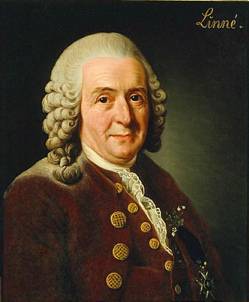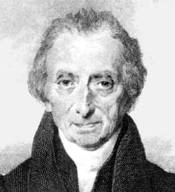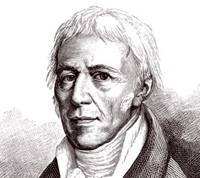On the Origins of New Forms of Life
1.4: Carolus Linnaeus
 Linnaeus
Linnaeus
(Continued from the previous page)
Carolus Linnaeus (1707-1788) was the first leading naturalist openly to challenge immutability, but in his youth he had begun, as one might expect, with the same views as his contemporaries. For example, in the Fundamenta Botanica (1736) he asserted "there are as many species as the Infinite Being created in the beginning."1
His extensive work in classification, however, exposed him to a variety of hybrids. These experiences eventually led him to change his views. The first encounter was with a plant for which he created the new genus Peloria.2 In Dissertatio Botanica de Peloria (1744) he asserted that it was a new type of plant of hybrid origin. In a letter to the Swiss naturalist Albrecht von Haller, he wrote,
He even went so far as to propose4 that all the various types of plants then in existence were derived from hybridization, beginning with a limited number of initial types created by divine fiat. However, his claims concerning Peloria and evolution through hybridization resulted both in professional embarrassment and in rebuke from the clergy.5 For a long time thereafter he was silent on the issue, but Peloria had drawn his attention to hybridization. Mention of hybridization was more frequent in his subsequent publications.6
References to plants of hybrid origin also increased in his works thereafter. In a 1751 letter to his close friend, the court physician Abraham Bäck, he said he had found hybrid plants to be "many in number," and that he believed through them he had been able to "open the door to one of nature's extensive chambers, although it is not opened without creaking."7
In an earlier letter (Carolus Linnaeus to Abraham Bäck, September 7, 1750), he had crowed over a recently discovered plant, Veronica spuria, which he judged to be the product of hybridization between the genera Verbena and Veronica:
During ensuing years he met with a variety of other plants that seemed also to be of hybrid origin.9,10 In Disquisitio de sexu plantarum (1760) he states that "it is impossible to doubt that there are new species produced by hybrid generation."11 There he lists four "to whose origin I have been an eyewitness"12 (Veronica spuria, Delphinium hybridum, Hieracium taraxici, and Tragopogon hybridum).13,14
Such observations eventually led him to reject the idea of immutability. From the twelfth edition of the Systema Naturae (1766) he removed his long-time mantra, "Nullae species novae" ("No new species"), and in his own copy of the Philosophia botanica, he crossed out the words "Natura non facit saltum" ("Nature makes no leaps").15 This is ironic since today he is often described as a conventional creationist by writers who unfairly focus on statements made in his earlier writings.
 Pallas
Pallas
Some naturalists subsequently expressed the same sort of ideas with respect to animals. Peter Simon Pallas (1741-1811) proposed that domestic animals arose in much the same way that Linnaeus said new plants did. In the Origin of Species Darwin says,
The idea is frequently encountered in pre-Darwinian literature. For example, Charles Howard Smith in his Natural History of Dogs (1839-1840), argued the various modern breeds of dogs
Morton (1847: 276) proposed a similar idea with respect to birds, in which he proposed that certain "original species" hybridized to give rise to the diversity of forms observed today.
 Lamarck
Lamarck
Ideas like those of Linnaeus were also countenanced by Jean-Baptiste Lamarck (1744-1829), who proposed in his Philosophie zoologique (1809) that hybridization was a potential source of new types of organisms. In the same work, he expressed his opinion that the data on hybridization even then available spoke against the idea of immutability:
1. Fundamenta botanica (No. 157, 1736). Translated by E. M. McCarthy. Carolus Linnaeus' Original Latin: "Species tot sunt diversae quot diversas formas ab initio creavit infinitum Ens."
2. Larson (1968: 293–295).
3. Smith (1821: vol. II, 376).
4. i.e., in Oratio de Telluris habitabilis incremento (Carolus Linnaeus, 1744).
5. Larsen (1968).
6. Larsen (1968: 295).
7. Fries and Hulth (1907–1922: vol. IV, 140). Translated in Larson (1968: 295). See also: Carolus Linnaeus (1756).
8. Fries and Hulth (1907–1922: vol. IV, 127). Translated in Larson (1968: 295).
9. Larsen (1968: 295).
10. It has been argued some of the plants Linnaeus considered hybrids were probably variants not of hybrid origin (e.g., Bremekamp 1952). However, even if such were the case, it would not change the fact that Carolus Linnaeus came to view hybridization as a source of new types of organisms.
11. Carolus Linnaeus translated in Grant (1981: 245).
12. Carolus Linnaeus translated in Zirkle (1935: 194).
13. Zirkle (1935: 194).
14. In the same publication he suggests there had initially been one type of plant in each genus and that subsequent diversification within each genus arose through hybridization (Larsen 1969: 296–297). In the twelfth edition of the Systema Naturae (1766) he expressed his opinion that in each taxonomic order, only one kind of plant had been initially created and that all those produced subsequently had arisen through hybridization (Larson 1971: 109; see also: Eriksson 1983: 93–97; Giseke 1792: 16, 18). He eventually pushed his speculations even further, asserting only three types of plants had been initially created, each representing one of three major divisions of the plant kingdom (Acotyledons, Monocotyledons, and Dicotyledons). From these three he suggested, all of the various plants now in existence, were created through hybridization (Larson 1971: 111).
15. Von Hofsten (1958); Zimmermann (1953).
16. Darwin (1859: 254).
17. Quoted in Morton (1847: 271).
18. Translated in Elliot (1914: 39).
Most shared on Macroevolution.net:
Human Origins: Are we hybrids?
On the Origins of New Forms of Life
Mammalian Hybrids
Cat-rabbit Hybrids: Fact or fiction?
Famous Biologists
Dog-cow Hybrids
Georges Cuvier: A Biography
Prothero: A Rebuttal
Branches of Biology
Dog-fox Hybrids